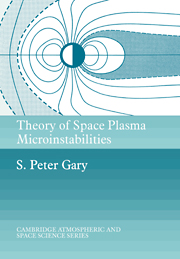Book contents
- Frontmatter
- Contents
- Preface
- 1 Introduction
- 2 Electrostatic waves in uniform plasmas
- 3 Electrostatic component/component instabilities in uniform plasmas
- 4 Electrostatic drift instabilities in inhomogeneous plasmas
- 5 Electromagnetic fluctuations in uniform plasmas
- 6 Electromagnetic waves in uniform plasmas
- 7 Electromagnetic temperature anisotropy instabilities in uniform plasmas
- 8 Electromagnetic component/component instabilities in uniform plasmas
- Appendix A The plasma dispersion function
- Appendix B Unperturbed orbits
- Appendix C Integral evaluation
- Index of symbols
- Index
7 - Electromagnetic temperature anisotropy instabilities in uniform plasmas
Published online by Cambridge University Press: 06 November 2009
- Frontmatter
- Contents
- Preface
- 1 Introduction
- 2 Electrostatic waves in uniform plasmas
- 3 Electrostatic component/component instabilities in uniform plasmas
- 4 Electrostatic drift instabilities in inhomogeneous plasmas
- 5 Electromagnetic fluctuations in uniform plasmas
- 6 Electromagnetic waves in uniform plasmas
- 7 Electromagnetic temperature anisotropy instabilities in uniform plasmas
- 8 Electromagnetic component/component instabilities in uniform plasmas
- Appendix A The plasma dispersion function
- Appendix B Unperturbed orbits
- Appendix C Integral evaluation
- Index of symbols
- Index
Summary
In this chapter we examine, as before, electromagnetic fluctuations in a homogeneous, magnetized, collisionless plasma. In contrast to the previous chapter, however, we admit anisotropies in the distribution functions. In particular we consider a two-temperature bi-Maxwellian zeroth-order distribution function; this permits the growth of temperature anisotropy instabilities. Section 7.1 outlines the derivation of the dispersion equation; Section 7.2 discusses the properties of modes driven unstable by a proton temperature anisotropy, whereas Section 7.3 discusses the properties of electron temperature anisotropy instabilities. Section 7.4 is a brief summary.
Our emphasis in this chapter is on instabilities driven by T⊥j > T‖ a condition that is observed more often in space plasmas than the converse T‖ > T⊥. The reason for this discrepancy is simple: although space plasmas do not necessarily exhibit a bias toward perpendicular heating processes, perpendicular heating does not much change the mobility of the heated particles, whereas parallel heating enables the particles to move more rapidly along B0. Thus parallel-heated particles may leave the region of energization more quickly, implying that T‖ > T⊥ should be a less frequently observed condition. Of course, parallel-heated particles may appear elsewhere as a magnetic-field aligned beam streaming against a cooler background plasma; the electromagnetic instabilities driven by such configurations have quite different properties from temperature anisotropy instabilities, and are studied in detail in the next chapter.
Information
- Type
- Chapter
- Information
- Theory of Space Plasma Microinstabilities , pp. 123 - 142Publisher: Cambridge University PressPrint publication year: 1993
Accessibility standard: Unknown
Why this information is here
This section outlines the accessibility features of this content - including support for screen readers, full keyboard navigation and high-contrast display options. This may not be relevant for you.Accessibility Information
- 3
- Cited by
